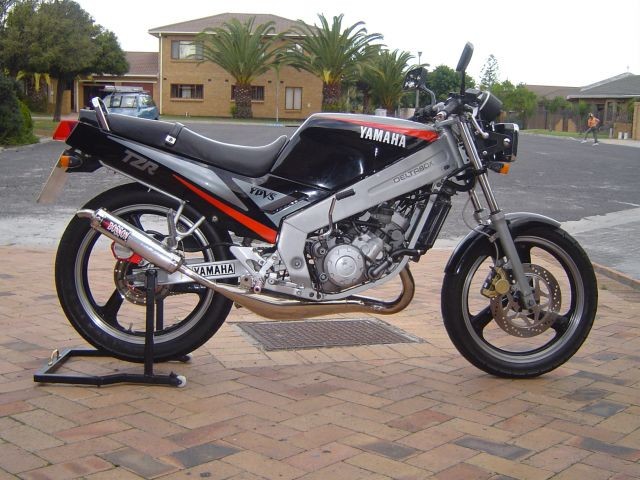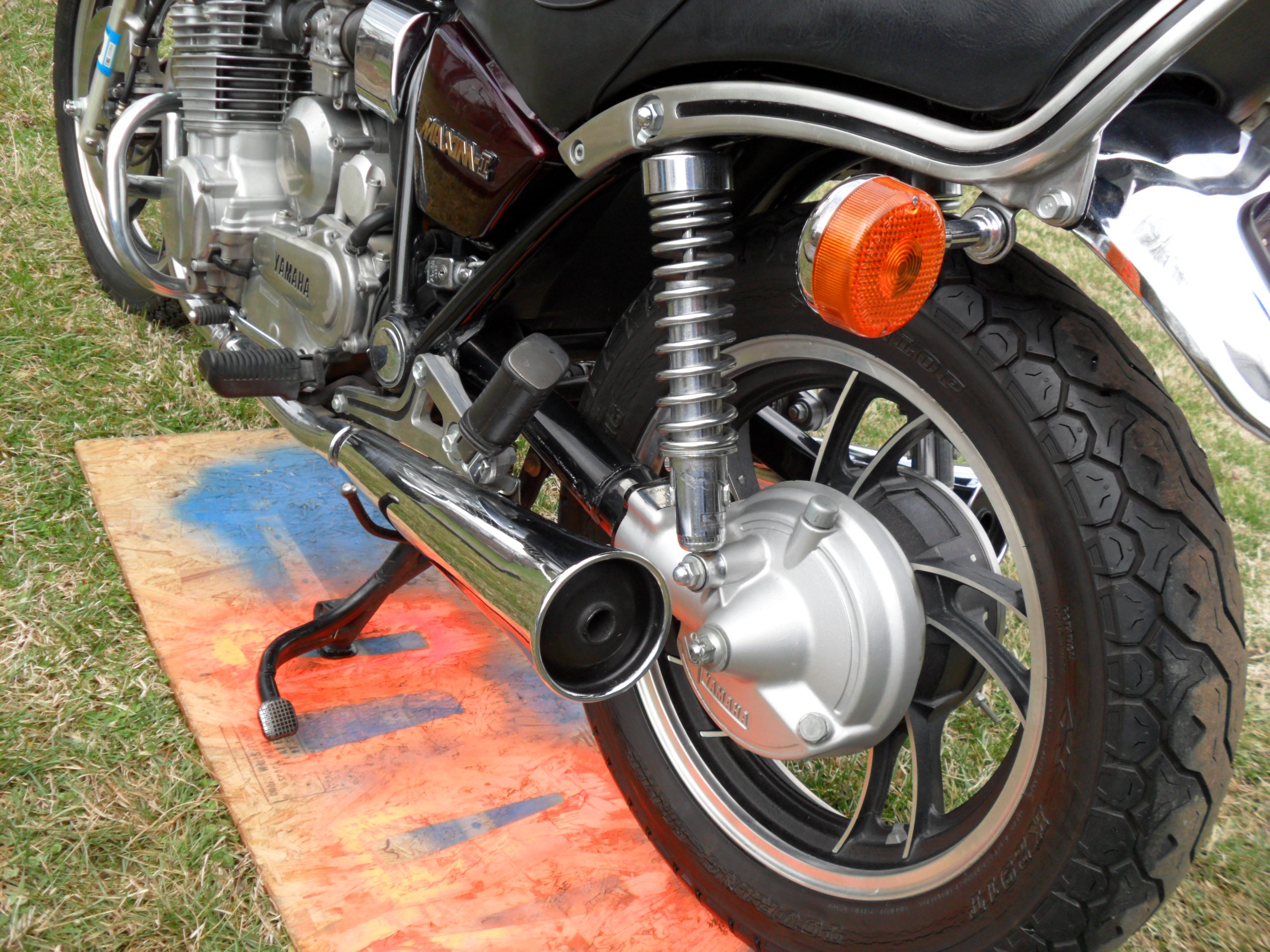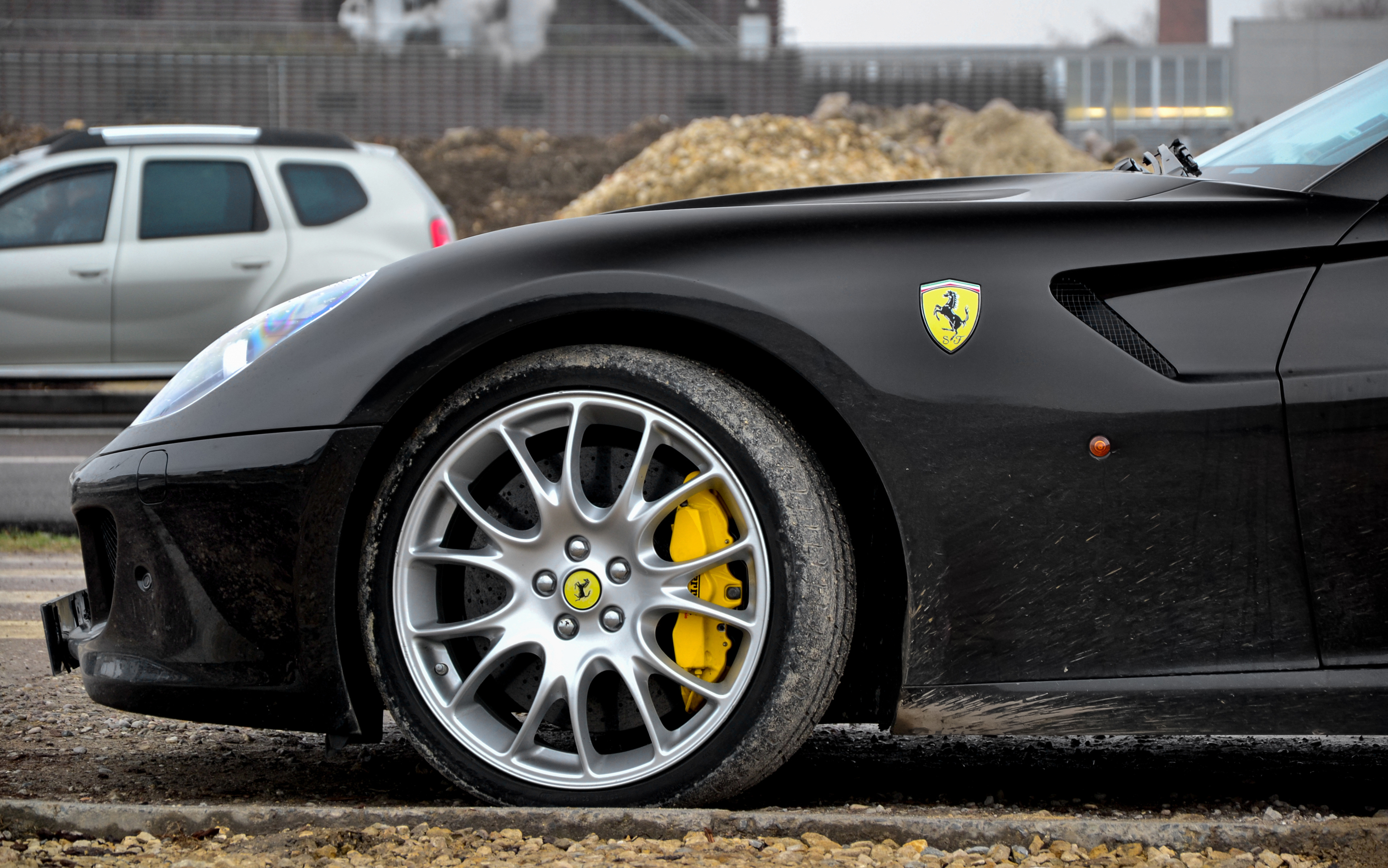|
Yamaha TZR125
The Yamaha TZR125 is a two-stroke sports motorcycle made for the European and South East Asian markets which uses the YPVS. The TZR125 was produced from 1987 and spanned two generations until the late 1990s each with a number of variants and sub variants. The Yamaha TZR125 can be seen in Wong Kar-Wai’s Fallen Angels where actor and singer Takeshi Kaneshiro drives it. First generation Yamaha introduced the TZR125 in 1987 and production ended in 1992. It is identified by the single square headlight at the front of the box fairing, clip-ons located on top of the yoke, single seat and conventional forks. Later TZR's can be identified by three-spoke alloy wheels and a rear disc brake. The first generation has a number of variants: 2RH; 2RJ; 2RK; 2RL; 2RM; 2RN; 2TU; 2UT; 2VR; 3FN; 3PA; 3PB; 3PC; 3PD; 3PE; 3SY; 3TY. First Generation TZR 4dl 1 (R) In 1991, Yamaha introduced the R series of TZR125s which have very little in common with the previous generation. Known as ... [...More Info...] [...Related Items...] OR: [Wikipedia] [Google] [Baidu] |
Yamaha Motor Company
is a Japanese multinational manufacturer of motorcycles, marine products such as boats and outboard motors, and other motorized products. The company was established in 1955 upon separation from Yamaha Corporation (however, Yamaha Corporation is still the largest private company shareholder with 9.92%, as of 2019), and is headquartered in Iwata, Shizuoka, Japan. The company conducts development, production and marketing operations through 109 consolidated subsidiaries as of 2012. Led by Genichi Kawakami, the company's founder and first president, Yamaha Motor spun off from musical instrument manufacturer Yamaha Corporation in 1955 and began production of its first product, the YA-1 125cc motorcycle. It was quickly successful and won the 3rd Mount Fuji Ascent Race in its class. The company's products include motorcycles, scooters, motorized bicycles, boats, sail boats, personal water craft, swimming pools, utility boats, fishing boats, outboard motors, 4-wheel ATVs, recreat ... [...More Info...] [...Related Items...] OR: [Wikipedia] [Google] [Baidu] |
Pillion
A pillion is a secondary pad, cushion, or seat behind the main seat or saddle on a horse, motorcycle, bicycle or moped. A passenger in this seat is said to "ride pillion". The word is derived from the Scottish Gaelic for "little rug", ''pillean'', from the Latin ''pellis'', "animal skin". One or more pelts often were used as a secondary seat on horseback; the usage has carried over to motorcycles. Historical references Following its retreat from the Battle of Dunkirk (where it is reputed that enough equipment was left behind to equip about eight to ten divisions), the British Army introduced a requirement that all officers up to the rank of colonel should be proficient in the use of the motorcycle, and all officers holding the rank of brigadier were required to be able to ride pillion. These requirements came about as a result of the large number of motor cars that were lost in action. The requirement for riding pillion was quietly dropped as large numbers of jeeps came into ser ... [...More Info...] [...Related Items...] OR: [Wikipedia] [Google] [Baidu] |
Yamaha Motorcycles
List of motorcycles manufactured by Yamaha Motor Company. First bikes * YA-1 built August 1954, produced January 1955. The first bike manufactured by Yamaha was actually a copy of the German DKW RT 125; it had an air-cooled, two-stroke, single cylinder 125 cc engine *YC-1 (1956) was the second bike manufactured by Yamaha; it was a 175 cc single cylinder two-stroke. * YD-1 (1957) Yamaha began production of its first 250 cc, two-stroke twin, the YD1. *MF-1 (1958) 50 cc, two-stroke, single cylinder, step through street bike *YDS-3 (1964) 246 cc, two-stroke, parallel-twin, it used the world's first oil injection lubrication system in a 2-stroke engine. * DT-1 (1968) Yamaha's first true off-road motorcycle. * XS-1 (1970) Yamaha's first four-stroke engine motorcycle (650 cc twin).http://www.yamaha-motor.com/corporate/historytimeline.aspx , Yamaha website timeline, accessed October 2, 2011 * Yamaha YZ Monocross (1975) First production motocross bike with a ... [...More Info...] [...Related Items...] OR: [Wikipedia] [Google] [Baidu] |
Yamaha XT 660
The Yamaha XT660 is dual-purpose on/off road motorcycles released by Yamaha Motors as a replacement for the XT600. It is a development of the original XT series ('X' stands for 4 strokes, 'T' for TRAIL), a line of motorcycles inspired by those used on the Paris Dakar rally. The first XT was released in 1976. The XT660R is the standard Enduro model ('R' stands for racing). A five-valve version of the 660 cc engine was used in a number of MZ (MuZ) motorcycles, including the MZ Skorpion The MZ Skorpion is a motorcycle made from 1994 to 2004 by MZ (MZ Motorrad- und Zweiradwerk), in former East Germany. The Scorpion is powered by a four-stroke five-valve 660 cc single-cylinder engine with liquid cooling. ''Skorpions'' ..., Baghira and Mastiff. After 2015 this bike was not sold in some European countries and US. Related Models Two other versions of this motorcycle are being produced alongside the XT660R – the XT660X, a more street-oriented supermoto ver ... [...More Info...] [...Related Items...] OR: [Wikipedia] [Google] [Baidu] |
Yamaha SZR660
Yamaha SZR660 is a sport bike with a single-cylinder engine, produced by Yamaha Motor Corporation from 1996 to 2001. It was built in Italy by the Italian Yamaha importer Belgarda. It shares its engine with Yamaha's XTZ660 Ténéré line of dual-purpose on/off-road motorcycles, but employs this engine within a Supermono Supermono is a class in European motorcycle road racing. Supermono class machines have a single-cylinder engine A single-cylinder engine, sometimes called a thumper, is a piston engine with one cylinder. This engine is often used for motorcycl ... package. The ''660'' engine incorporates a five-valve cylinder-head. There are three intake and two exhaust valves. The theory is that the smaller valves have a larger area at a lower weight than a four valve system and allow maximum intake flow and velocity. A vacuum operated fuel pump is mounted on the bottom of the fuel tank to lift the contents of the tank to the twin carburetors. The fuel system incorporate ... [...More Info...] [...Related Items...] OR: [Wikipedia] [Google] [Baidu] |
Yamaha TZR250
The Yamaha TZR250 is a motorcycle manufactured and produced by the Japanese motorcycle manufacturer Yamaha between 1986 and 1995. Yamaha produced the road going two-stroke motorcycle, loosely based on the TZ250 Yamaha racing bike. Parallel-twin, reverse cylinder and finally 90° V-twin variants were produced. It evolved as a natural replacement for the popular RD 250/Yamaha RD350LC series of the 1980s. It has the Yamaha Power Valve System 'YPVS' which raises and lowers the exhaust port depending on the rpm of the engine. The YPVS servo motor starts to open at about 6,000rpm. In standard form it produced 45 hp due to the restrictive standard exhausts and ignition boxes. Racing The TZR250 was still raced in the Yamaha Past Masters race series with the British racing club (BMCRC The British Motorcycle Racing Club (BMCRC), informally Bemsee, is the largest motorcycle racing club of its type in the UK and organises a range of championships including Clubman and Supersport ... [...More Info...] [...Related Items...] OR: [Wikipedia] [Google] [Baidu] |
Swingarm
A swingarm, or "swinging arm" (UK), originally known as a swing fork or pivoted fork, is a single or double sided mechanical device which attaches the rear wheel of a motorcycle to its body, allowing it to pivot vertically. The main component of the rear suspension of most modern motorbikes and ATVs, it holds the rear axle firmly, while pivoting to absorb bumps and suspension loads induced by the rider, acceleration, and braking. Originally motorcycles had no rear suspension, as their frames were little more than stronger versions of the classic diamond frame of a bicycle. Many types of suspension were tried, including Indian's leaf spring suspended swingarm, and Matchless's cantilevered coiled-spring swingarm. Immediately before and after World War II, the plunger suspension, in which the axle moved up and down two vertical posts, became commonplace. In the latter, the movement in each direction was against coiled springs. Some manufacturers, such as Greeves, used swingarm d ... [...More Info...] [...Related Items...] OR: [Wikipedia] [Google] [Baidu] |
Crankcase
In a piston engine, the crankcase is the housing that surrounds the crankshaft. In most modern engines, the crankcase is integrated into the engine block. Two-stroke engines typically use a crankcase-compression design, resulting in the fuel/air mixture passing through the crankcase before entering the cylinder(s). This design of the engine does not include an oil sump in the crankcase. Four-stroke engines typically have an oil sump at the bottom of the crankcase and the majority of the engine's oil is held within the crankcase. The fuel/air mixture does not pass through the crankcase in a four-stroke engine, however a small amount of exhaust gasses often enter as "blow-by" from the combustion chamber. The crankcase often forms the lower half of the main bearing journals (with the bearing caps forming the other half), although in some engines the crankcase completely surrounds the main bearing journals. An ''open-crank'' engine has no crankcase. This design was used in early ... [...More Info...] [...Related Items...] OR: [Wikipedia] [Google] [Baidu] |
Minarelli
Minarelli is an Italian motorcycle engine manufacturer. It is part of the Fantic Motor Fantic Motor is an Italian manufacturer of motorcycles. History Fantic Motor began in 1968, manufacturing and exporting enduro motorcycles, mini-bikes and go-karts. Today they continue in the same genre, though the names have changed to dual ... group. History Minarelli was founded in Bologna in 1951 as a motorcycle manufacturer. In 1954 it also began to build mopeds. Two years later Minarelli switched exclusively to 2-stroke engine manufacture and a new 2000 square metre factory was constructed for these purposes. It employed 20 technical staff and produced 70 engines a day. These were sold to companies in Italy, other parts of Europe and South America. In 1967 the company changed its name to Motori Minarelli and opened a new plant in Calderara di Reno. By the 1970s engine production had reached 250,000 units a year. The company also entered motorcycle racing and won a number ... [...More Info...] [...Related Items...] OR: [Wikipedia] [Google] [Baidu] |
Brembo
Brembo S.p.A. is an Italian manufacturer of automotive brake systems, especially for high-performance cars and motorcycles. Its head office is in Curno, Bergamo, Italy. History Brembo was established in Paladina, Italy on January 11, 1961 by Emilio Bombassei and Italo Breda (father and uncle, respectively, to the current Chairman Alberto Bombassei). The company was named after the Brembo river, as Bombassei lived in a village on the coast of the river before moving to Milan. Soon after Brembo was formed, it specialized in disc brakes, which were imported from the UK at the time. The company entered into a supply contract with Alfa Romeo in 1964 and became Moto Guzzi's brake component supplier in 1966. In the 1980s, Brembo also began supplying brakes to BMW, Chrysler, Ferrari, Mercedes-Benz, Nissan, and Porsche. Brembo went public on the Milan Stock Exchange in 1995. In 2000, Brembo purchased the UK-based racing brake and clutch manufacturer AP Racing (a former division ... [...More Info...] [...Related Items...] OR: [Wikipedia] [Google] [Baidu] |
Disc Brake
A disc brake is a type of brake that uses the calipers to squeeze pairs of pads against a disc or a "rotor" to create friction. This action slows the rotation of a shaft, such as a vehicle axle, either to reduce its rotational speed or to hold it stationary. The energy of motion is converted into waste heat which must be dispersed. Hydraulically actuated disc brakes are the most commonly used form of brake for motor vehicles, but the principles of a disc brake are applicable to almost any rotating shaft. The components include the disc, master cylinder, and caliper (which contains a cylinder and two brake pads) on both sides of the disc. Design The development of disc-type brakes began in England in the 1890s. In 1902, the Lanchester Motor Company designed brakes that looked and operated in a similar way to a modern disc-brake system even though the disc was thin and a cable activated the brake pad. Other designs were not practical or widely available in cars for another 6 ... [...More Info...] [...Related Items...] OR: [Wikipedia] [Google] [Baidu] |






.jpg)

